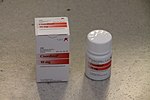Zuclopenthixol
 | |
| Clinical data | |
|---|---|
| Trade names | Clopixol |
| AHFS/Drugs.com | International Drug Names |
| Pregnancy category |
|
| Routes of administration | Oral, IM |
| Drug class | Typical antipsychotic |
| ATC code | |
| Legal status | |
| Legal status | |
| Pharmacokinetic data | |
| Bioavailability | 49% (oral) |
| Protein binding | 98% |
| Metabolism | Liver (CYP2D6 and CYP3A4-mediated) |
| Elimination half-life | 20 hours (oral), 19 days (IM) |
| Excretion | Feces |
| Identifiers | |
| |
JSmol) | |
| |
| |
| | |
Zuclopenthixol (brand names Cisordinol, Clopixol and others), also known as zuclopentixol, is a medication used to treat
Clopenthixol was introduced in 1961, while zuclopenthixol was introduced in 1978.Zuclopenthixol is a
Medical uses
Available forms
Zuclopenthixol is available in three major
- As zuclopenthixol decanoate (Clopixol Depot, Cisordinol Depot), it is a long-acting intramuscular injection. Its main use is as a long-acting injection given every two or three weeks to people with schizophrenia who have a poor compliance with medication and suffer frequent relapses of illness.[7] There is some evidence it may be more helpful in managing aggressive behaviour.[8]
- As zuclopenthixol acetate (Clopixol-Acuphase, Cisordinol-Acutard), it is a shorter-acting intramuscular injection used in the acute sedation of psychotic inpatients. The effect peaks at 48–72 hours providing 2–3 days of sedation.[9]
- As zuclopenthixol dihydrochloride (Clopixol, Cisordinol), it is a tablet used in the treatment of schizophrenia in those who are compliant with oral medication.[10]
It is also used in the treatment of acute
Dosing
As a long-acting injection, zuclopenthixol decanoate comes in a 200 mg and 500 mg ampoule. Doses can vary from 50 mg weekly to the maximum licensed dose of 600 mg weekly. In general, the lowest effective dose to prevent relapse is preferred. The interval may be shorter as a patient starts on the medication before extending to 3 weekly intervals subsequently. The dose should be reviewed and reduced if side effects occur, though in the short-term an anticholinergic medication
In acutely psychotic and agitated inpatients, 50 – 200 mg of zuclopenthixol acetate may be given for a calming effect over the subsequent three days, with a maximum dose of 400 mg in total to be given. As it is a long-acting medication, care must be taken not to give an excessive dose.
In oral form zuclopenthixol is available in 2, 10, 25 and 40 mg tablets, with a dose range of 20–60 mg daily.[11]
Side effects
Chronic administration of zuclopenthixol (30 mg/kg/day for two years) in rats resulted in small, but significant, increases in the incidence of thyroid parafollicular carcinomas and, in females, of mammary adenocarcinomas and of pancreatic islet cell adenomas and carcinomas. An increase in the incidence of mammary adenocarcinomas is a common finding for D2 antagonists which increase prolactin secretion when administered to rats. An increase in the incidence of pancreatic islet cell tumours has been observed for some other D2 antagonists. The physiological differences between rats and humans with regard to prolactin make the clinical significance of these findings unclear.
Withdrawal syndrome: Abrupt cessation of therapy may cause acute withdrawal symptoms (eg, nausea, vomiting, or insomnia). Symptoms usually begin in 1 to 4 days of withdrawal and subside within 1 to 2 weeks.[12][13]
Other permanent side effects are similar to many other typical antipsychotics, namely
Zuclopenthixol decanoate induces a transient dose-dependent sedation. However, if the patient is switched to maintenance treatment with zuclopenthixol decanoate from oral zuclopenthixol or from i.m. zuclopenthixol acetate the sedation will be no problem. Tolerance to the unspecific sedative effect develops rapidly.[14]
- Very common Adverse Effects (≥10% incidence) [15]
- Dry Mouth
- Somnolence
- Akathisia
- Hyperkinesia
- Hypokinesia
- Common (1–10%) [15]
- Tachycardia
- Heart palpitations
- Vertigo
- Accommodation disorder
- Abnormal vision
- Salivary hypersecretion
- Constipation
- Vomiting
- Dyspepsia
- Diarrhoea
- Asthenia
- Fatigue
- Malaise
- Pain (at the injection site)
- Increased appetite
- Weight gain
- Myalgia
- Tremor
- Dystonia
- Hypertonia
- Dizziness
- Headache
- Paraesthesia
- Disturbance in attention
- Amnesia
- Abnormal gait
- Insomnia
- Depression
- Anxiety
- Abnormal dreams
- Agitation
- Decreased libido
- Nasal congestion
- Dyspnoea
- Hyperhidrosis
- Pruritus
- Uncommon (0.1–1%)[15]
- Hyperacusis
- Tinnitus
- Mydriasis
- Abdominal pain
- Nausea
- Flatulence
- Thirst
- Injection site reaction
- Hypothermia
- Pyrexia
- Abnormal liver function tests
- Decreased appetite
- Weight loss
- Muscle rigidity
- Trismus
- Torticollis
- Tardive dyskinesia
- Hyperreflexia
- Dyskinesia
- Parkinsonism
- Syncope
- Ataxia
- Speech disorder
- Hypotonia
- Convulsion
- Migraine
- Apathy
- Nightmares
- Libido increased
- Confused state
- Ejaculation failure
- Erectile dysfunction
- Female orgasmic disorder
- Vulvovaginal
- Dryness
- Rash
- Photosensitivity
- Pigmentation disorder
- Seborrhoea
- Dermatitis
- Purpura
- Hypotension
- Hot flush
- Rare (0.01–0.1%)[15]
- Thrombocytopenia
- Neutropenia
- Leukopenia
- Agranulocytosis
- QT prolongation
- Hyperprolactinaemia
- Hypersensitivity
- Anaphylactic reaction
- Hyperglycaemia
- Glucose tolerance impaired
- Hyperlipidaemia
- Gynaecomastia
- Galactorrhoea
- Amenorrhoea
- Priapism
- Withdrawal symptoms
- Very rare (<0.01%)[15]
- Cholestatic hepatitis
- Jaundice
- Neuroleptic malignant syndrome
- Venous thromboembolism
Pharmacology
Pharmacodynamics

Zuclopenthixol antagonises both dopamine
Evidence from in vitro work and clinical sources (i.e. therapeutic drug monitoring databases) suggests that both CYP2D6 and CYP3A4 play important roles in zuclopenthixol metabolism.[16]
Pharmacokinetics
| Medication | Brand name | Class | Vehicle | Dosage | Tmax | t1/2 single | t1/2 multiple | logPc | Ref |
|---|---|---|---|---|---|---|---|---|---|
| Aripiprazole lauroxil | Aristada | Atypical | Watera | 441–1064 mg/4–8 weeks | 24–35 days | ? | 54–57 days | 7.9–10.0 | |
Aripiprazole monohydrate |
Abilify Maintena | Atypical | Watera | 300–400 mg/4 weeks | 7 days | ? | 30–47 days | 4.9–5.2 | |
| Bromperidol decanoate | Impromen Decanoas | Typical | Sesame oil | 40–300 mg/4 weeks | 3–9 days | ? | 21–25 days | 7.9 | [17] |
Clopentixol decanoate |
Sordinol Depot | Typical | Viscoleob | 50–600 mg/1–4 weeks | 4–7 days | ? | 19 days | 9.0 | [18] |
Flupentixol decanoate |
Depixol | Typical | Viscoleob | 10–200 mg/2–4 weeks | 4–10 days | 8 days | 17 days | 7.2–9.2 | [18][19] |
Fluphenazine decanoate |
Prolixin Decanoate | Typical | Sesame oil | 12.5–100 mg/2–5 weeks | 1–2 days | 1–10 days | 14–100 days | 7.2–9.0 | [20][21][22] |
Fluphenazine enanthate |
Prolixin Enanthate | Typical | Sesame oil | 12.5–100 mg/1–4 weeks | 2–3 days | 4 days | ? | 6.4–7.4 | [21] |
| Fluspirilene | Imap, Redeptin | Typical | Watera | 2–12 mg/1 week | 1–8 days | 7 days | ? | 5.2–5.8 | [23] |
| Haloperidol decanoate | Haldol Decanoate | Typical | Sesame oil | 20–400 mg/2–4 weeks | 3–9 days | 18–21 days | 7.2–7.9 | [24][25] | |
Olanzapine pamoate |
Zyprexa Relprevv | Atypical | Watera | 150–405 mg/2–4 weeks | 7 days | ? | 30 days | – | |
| Oxyprothepin decanoate | Meclopin | Typical | ? | ? | ? | ? | ? | 8.5–8.7 | |
Paliperidone palmitate |
Invega Sustenna | Atypical | Watera | 39–819 mg/4–12 weeks | 13–33 days | 25–139 days | ? | 8.1–10.1 | |
Perphenazine decanoate |
Trilafon Dekanoat | Typical | Sesame oil | 50–200 mg/2–4 weeks | ? | ? | 27 days | 8.9 | |
| Perphenazine enanthate | Trilafon Enanthate | Typical | Sesame oil | 25–200 mg/2 weeks | 2–3 days | ? | 4–7 days | 6.4–7.2 | [26] |
Pipotiazine palmitate |
Piportil Longum | Typical | Viscoleob | 25–400 mg/4 weeks | 9–10 days | ? | 14–21 days | 8.5–11.6 | [19] |
Pipotiazine undecylenate |
Piportil Medium | Typical | Sesame oil | 100–200 mg/2 weeks | ? | ? | ? | 8.4 | |
| Risperidone | Risperdal Consta | Atypical | Microspheres |
12.5–75 mg/2 weeks | 21 days | ? | 3–6 days | – | |
| Zuclopentixol acetate | Clopixol Acuphase | Typical | Viscoleob | 50–200 mg/1–3 days | 1–2 days | 1–2 days | 4.7–4.9 | ||
| Zuclopentixol decanoate | Clopixol Depot | Typical | Viscoleob | 50–800 mg/2–4 weeks | 4–9 days | ? | 11–21 days | 7.5–9.0 | |
| Note: All by . Sources: Main: See template. | |||||||||
History
Zuclopenthixol was introduced by Lundbeck in 1978.[27]
References
- ^ "Clopixol (Zuclopenthixol Hydrochloride) Film-coated tablets". Australian Product Information. Australia: The Therapeutics Goods Administration. Archived from the original on 2018-06-15. Retrieved 2013-08-08.
- ^ Anvisa (2023-03-31). "RDC Nº 784 - Listas de Substâncias Entorpecentes, Psicotrópicas, Precursoras e Outras sob Controle Especial" [Collegiate Board Resolution No. 784 - Lists of Narcotic, Psychotropic, Precursor, and Other Substances under Special Control] (in Brazilian Portuguese). Diário Oficial da União (published 2023-04-04). Archived from the original on 2023-08-03. Retrieved 2023-08-16.
- ISBN 0-471-89980-1. Archivedfrom the original on 2023-04-29. Retrieved 2020-10-07.
- PMID 6144029.
- PMID 17574793.
- ISBN 978-0-85369-840-1.
- ^ from the original on 2007-06-13. Retrieved 2007-06-12.
- PMID 17470962.
- ^ Lundbeck P/L (1991). "Clopixol Acuphase 50 mg/mL Injection Clopixol Acuphase 100 mg / 2 mL Injection". Lundbeck P/L. Archived from the original on 2007-06-09. Retrieved 2007-06-12.
- ^ PMID 29144549.
- ^ "Clopixol 2 mg film-coated tablets - Summary of Product Characteristics (SmPC) - (emc)". www.medicines.org.uk. Archived from the original on 2023-03-28. Retrieved 2023-03-28.
- ^ [1]
- ^ [2]
- ^ "Summary of Product Characteristics" (PDF). Archived (PDF) from the original on 2017-03-28. Retrieved 2017-03-28.
- ^ a b c d e "TGA eBS - Product and Consumer Medicine Information Licence". Archived from the original on 2018-06-15. Retrieved 2013-08-08.
- S2CID 41869401.
- ^ Parent M, Toussaint C, Gilson H (1983). "Long-term treatment of chronic psychotics with bromperidol decanoate: clinical and pharmacokinetic evaluation". Current Therapeutic Research. 34 (1): 1–6.
- ^ PMID 6931472.
- ^ a b Reynolds JE (1993). "Anxiolytic sedatives, hypnotics and neuroleptics.". Martindale: The Extra Pharmacopoeia (30th ed.). London: Pharmaceutical Press. pp. 364–623.
- PMID 6143748.
- ^ PMID 444352.
- ^ Young D, Ereshefsky L, Saklad SR, Jann MW, Garcia N (1984). Explaining the pharmacokinetics of fluphenazine through computer simulations. (Abstract.). 19th Annual Midyear Clinical Meeting of the American Society of Hospital Pharmacists. Dallas, Texas.
- PMID 4992598.
- PMID 3545764.
- PMID 7185768.
- ^ Larsson M, Axelsson R, Forsman A (1984). "On the pharmacokinetics of perphenazine: a clinical study of perphenazine enanthate and decanoate". Current Therapeutic Research. 36 (6): 1071–88.
- ISBN 978-0-8155-1856-3. Archivedfrom the original on 14 January 2023. Retrieved 27 September 2017.
